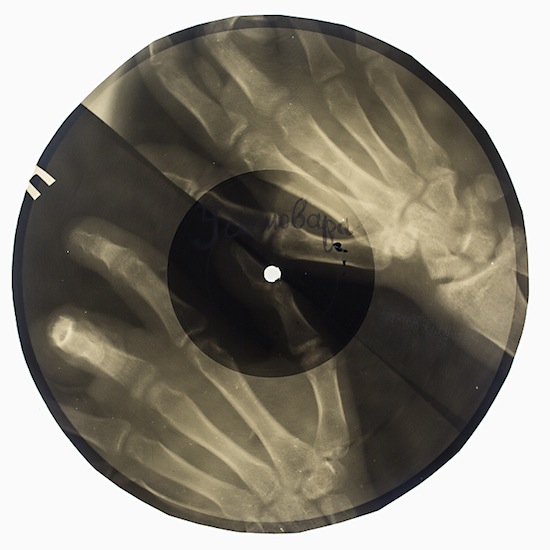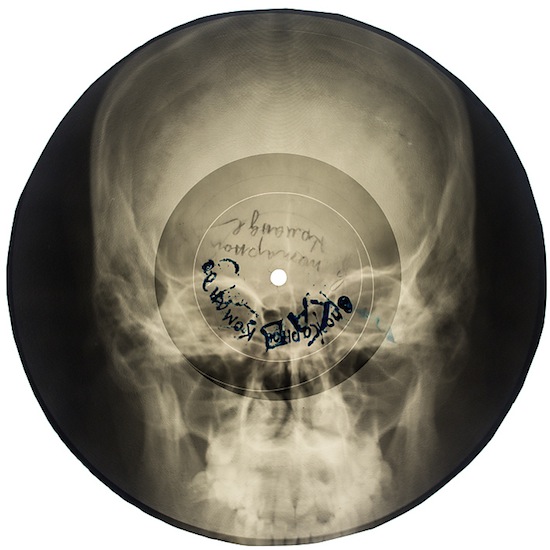Photographs courtesy of Paul Heartfield
You have thousands of songs on your computer or MP3 player, right? But is there anything on there which is illegal? Can you imagine a police officer trawling through your music collection and finding a track, by say The Real Tuesday Weld, and arresting you? Probably not, but if we rewind the tape, travel back through time 60 years or more to a place a thousand miles away, things look very different.
We are in St Petersburg in a park, approaching a shady-looking guy in a raincoat. He recognises us, nods and opens his coat. He pulls something flat from under his shirt and pushes it toward us. We read the writing scrawled on the surface, nod back, get out our wallet and give him some money. The whole transaction has taken only a few seconds and as the shady guy moves away, we excitedly turn and head home, carefully clutching our prize. This isn’t a story about drugs or contraband watches, it is a story of forbidden music, Cold War culture, bootleg technology and, most of all, human endeavour.
In the Soviet Union in the years after the Second World War, a lot of music was banned. Most Western music was banned just because it was Western. The official reason given might be that it was ‘neo-fascist’, ‘mystical’ or ‘wilfully obscure’, but really it was just because it was American or British. A lot of Russian music was also forbidden. Anything made by emigres or dissidents was off-limits because, by definition, any Russian who had left the country or who stayed away by choice was considered a traitor, whatever their repertoire and even if they had previously been approved of. But what is perhaps more difficult for us to comprehend is that much domestic Russian music was also forbidden, or at the very least deemed ‘unofficial’. Why?
Well, especially during the heat of the Stalinist era, all Soviet art, literature, poetry, film and music was controlled. The ideologues of the Soviet Union believed that all art had to be in the service of socialist realism and communist ideals, and therefore it was all subject to an official censor. Self expression was out. Many Russian popular tunes, especially those from the folk tradition called ‘criminal’ songs, were not anti-Soviet as such but were still deemed to be ‘low culture’ and would not pass the censors. Many of these songs had become popular in the gulags. Like a Jacques Brel track, they might be about violence or jealousy or the rough and tumble of love and lust and life in the camps. A Russian friend said to me recently: "Remember, at that time, every family had at least one member in the gulag." Even certain rhythms, such as the foxtrot, were banned as they might lead to licentious behaviour, late-night gatherings and general frivolity.
But if so much was forbidden, what was actually approved? Much wonderful classical music was fine, of course, and popular music deemed to be supportive of the socialist idealisation of the working class was encouraged. Pretty worthy stuff, you might imagine. I have a a vinyl EP called Pioneers’ Songs by the Soviet Communist Scouts Organisation. It was released on Melodiya, the official state record label. The song titles give an idea of the content: ‘BURN THE FIRES UP!’, ‘POTATOES’, ‘ATTENTION’, ‘START!’, ‘PIONEER’S ROAD SONG’… Probably not the sort of stuff to get young hearts beating as one, right?
But young hearts were beating. People had a huge pent-up desire to hear their own music: songs they had heard in the gulag or sung by those who had returned; songs they had loved in earlier, less-controlled times; songs by artists who were now persona non grata and even perhaps songs they had heard played by some local singer at a clandestine concert. And of course there was a demand for the impossibly exotic-seeming Western music, the rock & roll or jazz which might be caught on an overseas radio broadcast the state hadn’t been able to jam or at a party on gramophone records smuggled into the country by merchant sailors or diplomats. Such records would be rare and fabulously expensive, costing the equivalent of a month’s wages perhaps. This combination of huge demand and a restricted supply is of course the perfect condition for a market to arise. And true to form, in stepped the bootleggers.
We had our own bootleg culture in the West once of course – live recordings of concerts made on vinyl or tape in the days before the internet changed everything. But even if illegal, these were relatively easy to make. In the Soviet Union during the period from the late 40s to the early 60s, it was not so easy. The bootleggers’ first technical problem – that of obtaining a machine to record with – was relatively straightforward. Literature existed explaining audio recording techniques (say in case a righteous citizen wanted to copy the speeches of Comrade Stalin) and various Telefunken recording machines had been brought back from Germany as trophies after the Second World War. These could be adapted or copied, but a further problem existed. The State completely controlled the recording industry and the means of manufacturing records. You couldn’t just go and buy the vinyl or shellac or lacquer needed in a store somewhere.

But at some point, an enterprising music lover hit on a genius idea. An alternative source of raw materials was available – used x-ray plates obtained from local hospitals. And that is where this story really begins. Many older people in Russia remember seeing and hearing strange vinyl-type discs when they were young. The discs had partial images of skeletons on them and were called ‘bones’ or ‘ribs’, and they contained wonderful music – music that was forbidden. The practice of copying and recording music onto x-rays got going in St Petersburg, a port where it was easier to obtain illicit records. But the practice spread, first to Moscow and then to most major conurbations throughout the Soviet Union.
I learned about the discs a few years ago during one of The Real Tuesday Weld’s trips to perform in Russia. The more I learned, the more I wanted to share their amazing story. So, with the photographer Paul Heartfield, for the last couple of years I have been interviewing and collecting images for The X-Ray Audio project, a UK Arts Council-sponsored initiative to record the testimony of people who were involved in this risky trade. As well as live events and a radio documentary, we will be publishing a book about the history of the x-ray records and the people who made them with Strange Attractor Press in 2015.
But we are also making new x-ray records. At our launch at London’s The Horse Hospital last month, sound artist and researcher Aleks Kolkowski cut a new plate using a vintage analogue record-cutting lathe from a Real Tuesday Weld track written especially for the occasion. We will be repeating the experiment for an upcoming radio documentary and for a special release for Rough Trade on Independent Record Store Day. And we will be back at The Horse Hospital in January with an exhibition of original Soviet x-ray records.
X-Ray Audio is a story about strange flexi-discs for sure, but it is also a story of people – music-lovers like us who wanted to share the music they loved. People for whom music held a value we can probably never really imagine. And for us, who can copy and share our music at the click of a mouse, who have thousands of songs at our fingertips and for whom nothing is forbidden, it might be worth reflecting on a time when just possessing a certain song could land you in trouble and when copying a record could land you in prison. A time when the sound of the music that you really loved was only available ‘off the bone’.
For more information on this fascinating project, please visit Stephen’s Bone Blog


